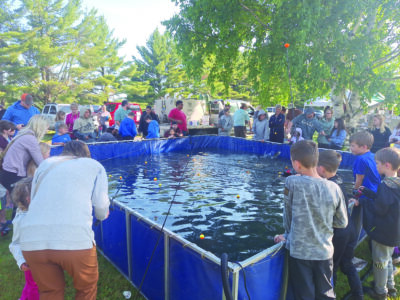INVASION UNDER WAY: Invasion of Europe begins in northern France

U.S. National Archives Elements of the 1st (Big Red One) Infantry Division assemble on Omaha Beach on June 6, 1944, which became the bloodiest beach of the Normandy Invasion.
HOUGHTON — On June 6, 1944, regular radio programming on WHDF was interrupted for an announcement issued by the British Broadcasting Corporation (BBC).
“The following communique has just been issued by Supreme Headquarters Allied Expeditionary Forces,” the announcement began. “Under the command of General Eisenhower, Allied naval forces, supported by strong air forces, began landing Allied armies this morning, on the northern coast of France.”
Later that day, residents received their Tuesday edition of the Daily Mining Gazette to read the bold, black headlines INVASION UNDER WAY across just beneath the Gazette banner. One of the front-page articles, written by Wes Gallagher for the Associated Press, carried the headlines YANKS, BRITISH, CANADIANS LAND ON FRENCH COAST. There they learned a few more of the limited details that were available:
JUNE 6 (AP) — American, British and Canadian airborne and seaborne forces landed in northwestern France today, establishing beachheads in Normandy and slashed inland in an auspicious start to history’s greatest overseas operation, aimed at liberating the peoples of Europe from German mastership,” Gallagher’s article began.
Supreme Headquarters Allied Expeditionary Forces (SHAEF) chose June 6 as D-Day for Operation Overlord, after an early May initial D-Day had to be abandoned, primary because of bad weather. Operation Overlord was the codename for the invasion of Normandy, one of 18 departments of France, known as the Duchy of Normandie. D-Day was a generic military term for the day of an invasion, the D standing simply for “Day.”
The invasion plans included dropping several airborne divisions into Normandy five hours before the seaborne invasion was to begin along a 50-mile front, divided into American, British and Canadian zones, five beaches.
The paratroopers were assigned, what many historians believe, was probably the most difficult task of the initial operation, a night jump behind enemy lines, with the missions to disrupt the German defense lines, capture and hold valuable road junctions, and use the element of surprise while the main force landed the beaches. The airborne landings needed to be carried out precisely, so that the troops wouldn’t scatter and fall victim to German patrols. It did not work out that way. Pilots overshot drop zones, others gave their passengers the signal to jump prematurely; other pilots got lost and missed drop zones by miles.
While the airborne divisions were either being deployed, had already landed, or were trying to find and reach their drop zones, Allied troops transferred from transports to landing craft, 12 miles off the French coast, in 13-foot seas of the English Channel. The five beaches had been previously assigned. The Americans would land on the right of the invasion front, on beaches codenamed Utah and Omaha, and while the British, Canadian and French were to land on the beaches Gold, Juno and Sword.
According to the Headquarters of the United States European Command (HUSEC), the total number of airborne troops involved was 23,400, among a total invasion force of 156,115. Of those, 73,000 Americans (including airborne) landed in the American sectors; 21,400 Canadians landed on Juno Beach; British numbers totaled 61,715, including airborne, on Gold and Sword Beaches. These three nations were not alone in representing Allied nation that day, however.
Also present were soldiers from Belgium, Norway, Poland, Luxembourg, Greece, Czechoslovakia, New Zealand, Australia, and more than 177 French commandos.
The assault phase of Overlord was named Operation Neptune, which began on June 6 and ended on June 30. It involved landing troops on beaches and all other associated supporting operations required to establish a beachhead in France, according to HUSEC. By June 30, the the Allies had established a firm foothold in Normandy: 850,279 men, 148,803 vehicles and 570,505 tons of supplies had been landed. Operation Overlord, which began on June 6, was concluded on August 19, 1944, when Allied forces crossed the River Sein. The period between June 6 and the end of August, 1944, has been named the Battle of Normandy.
Allied casualties for D-day have generally been estimated at 10,000, including 4,213 killed. The U.S. National D-Day Memorial Foundation recently achieved a fairly accurate count. The organization verified 2,499 American dead, 1,914 killed from the other Allied nations, for a total of 4,413.





